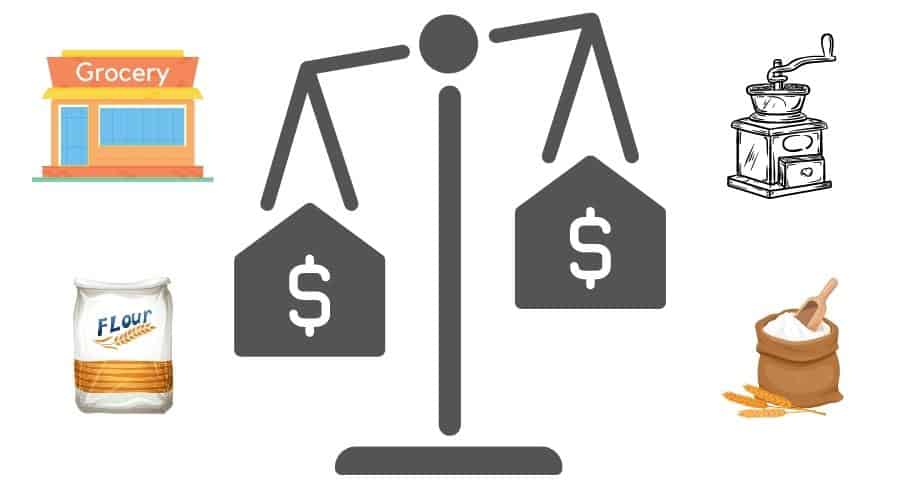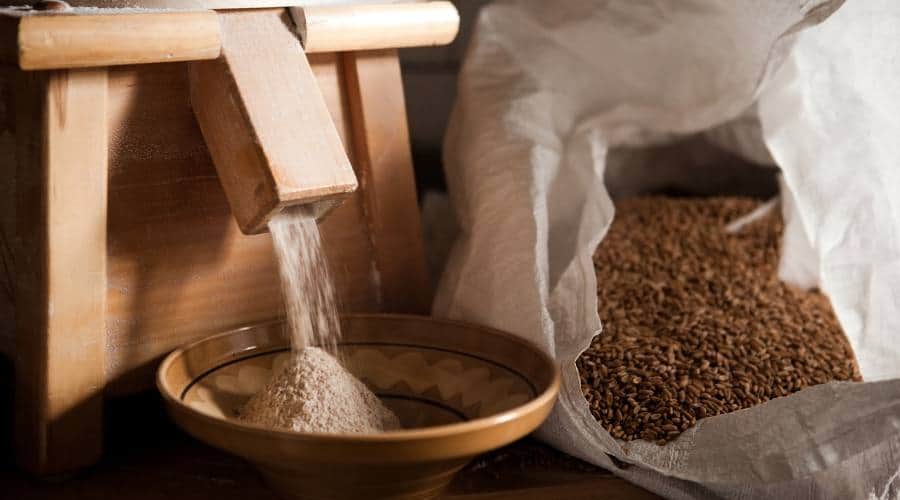Are you someone who loves the taste and texture of whole wheat flour, but not so much the price tag that often comes with it? You may have wondered if it’s cheaper to grind your own flour instead of buying pre-ground flour from the store. This is a great question, and in this article, we will take a look at a cost comparison of store-bought and homemade flour, the savings over time, and the pros and cons of both.
By the end of this post, you’ll have a better understanding of whether it’s more cost-effective to grind your own wheat flour or to buy it pre-ground, So, is it cheaper to grind your own whole wheat flour? Keep reading to find out!
Is it Cheaper to Grind Your Own Flour?
It can be cheaper to grind your own whole wheat flour if you purchase your grains in bulk and have a good quality grain mill/flour grinder. The cost of store-bought whole wheat flour can vary depending on the type and brand, but grinding your own flour allows you to choose the cheapest and freshest ingredients.
So in short, finding and purchasing your own grains in bulk, along with a high-quality flour mill/grinder (see our top grain/flour mill picks) may save you money over the long run verse buying high-quality whole wheat flour. Additionally, grinding your own flour can reduce packaging and transportation costs, making it a more environmentally friendly choice.
Keep in mind, it might be a little cheaper to buy a generic all-purpose flour than grinding your own whole wheat flour from a high-quality specialty grain. So make sure to compare apples to apples and compare the same grains before you purchase any in bulk.
If you start grinding your own flour or buy it in bulk you’ll want to know how to store it correctly to get the longest shelf life. For help see our guide on how to store flour long-term.
In this article, we’ll dive into the cost comparison of store-bought versus homemade flour and the benefits of grinding your own. We’ll also provide tips on how to successfully grind your own flour at home. So if you’re ready to take control of your baking ingredients and save some money in the process, read on!

The Cost Comparison: Store-Bought vs Homemade Flour
Breakdown of the Cost of Store-Bought Flour
When it comes to the cost of store-bought flour, it’s important to compare prices and look for sales or discounts to get the best deal. The price of store-bought flour can vary depending on the type and brand. For example, a 5-pound bag of all-purpose flour may cost $3.50 at one store and $4.50 at another. It’s a good idea to shop around and see which store has the best price for the type of flour you need.
In addition to the price of the flour itself, it’s important to consider the cost of packaging and transportation. These costs can add up and contribute to the overall price of the flour.
By comparing the price of store-bought flour with the cost of ingredients for homemade flour, you can determine if grinding your own flour is a more cost-effective option for you.
Cost of Ingredients for Homemade Flour
Grinding your own flour requires grains such as wheat, oats, or rye (see how to store wheat berries long-term). These grains can be purchased in bulk at a lower cost than pre-ground flour. For example, a 50-pound bag of wheat berries may cost around $40, while a 5-pound bag of all-purpose flour may cost $4. This means that the cost per serving of homemade flour is significantly lower than store-bought flour.
It’s important to calculate the cost per serving of homemade flour to determine if it is a cheaper option for you. To do this, divide the cost of the grains by the number of servings that the grains will yield. For example, if a 50-pound bag of wheat berries costs $30 and yields 50 cups of flour, the cost per serving is $0.60 per cup.
Keep in mind that the cost of ingredients for homemade flour may vary depending on where you live and the availability of grains. It may be necessary to shop around and compare prices at different stores or online to get the best deal.
Comparison of Prices of Different Types of Flour
Different types of flour, such as whole wheat or all-purpose, may have different prices at the store. For example, a 5-pound bag of whole wheat flour may cost $5, while a 5-pound bag of all-purpose flour may cost $4. Grinding your own flour allows you to choose the type of grain and create your own blend, potentially saving money.
To determine the most cost-effective option, it is important to compare the cost of store-bought and homemade versions of different types of flour. For example, if you prefer the taste and texture of whole wheat flour but find it too expensive to purchase, you can try grinding your own at home using wheat berries.
Keep in mind that the cost of ingredients for homemade flour may vary depending on where you live and the availability of grains. It may be necessary to shop around and compare prices at different stores or online to get the best deal. By doing your research and calculating the cost per serving of homemade flour, you can determine the most cost-effective option for your needs.
Is it Cheaper to Grind Your Own Gluten-Free Flour?
It can be cheaper to grind your own gluten-free flour if you purchase the grains in bulk and have a good-quality grain mill or blender. Gluten-free flours can be expensive to purchase at the store, especially if you are using a specific type of flour such as almond or coconut. By grinding your own gluten-free flour at home, you can choose the grains that you want to use and create your own blend, potentially saving money.
However, it’s important to note that some grains may be more expensive than others, so it’s a good idea to compare prices and do some cost calculations to determine if grinding your own gluten-free flour is a more cost-effective option for you. For example, if you use a lot of almond flour in your baking and it is cheaper to purchase pre-ground almond flour than to buy whole almonds and grind them yourself, it may not be worth the effort to grind your own gluten-free flour.

The Benefits of Grinding Your Own Flour
There are several benefits to grinding your own flour, including saving money, ensuring freshness and nutrients, and being able to customize the type of flour you use. Grinding your own flour also has a lower environmental impact due to reduced packaging and transportation costs.
Freshness and Nutrients
Homemade flour is fresher and has more nutrients than store-bought flour. When flour is ground at a mill, it is usually packaged and shipped to stores, which can take several weeks. During this time, the flour can lose some of its nutrients and freshness. By grinding your own flour at home, you can ensure that your flour is as fresh as possible and retains as many nutrients as possible.
Customization
Grinding your own flour allows you to choose which grains to use and create your own blend. This gives you control over the flavor and nutritional content of your flour. For example, if you want to create a high-protein flour blend, you can mix together different grains such as wheat, oats, and rye.
Reduced packaging and transportation costs
Homemade flour has a lower environmental impact because it reduces the need for packaging and transportation. Store-bought flour is packaged in bags or boxes and shipped to stores, which can contribute to environmental pollution. By grinding your own flour at home, you can reduce your carbon footprint and do your part to protect the environment.
How to Grind Your Own Flour
Grinding your own flour at home is a simple process and can be done with a few basic tools. Here are some tips on how to successfully grind your own flour at home:
Tools needed:
- Grain mill: This is a kitchen appliance that grinds grains into flour. It typically has a hopper where you can pour the grains, and a crank or electric motor that grinds the grains into flour. Some grain mills also have multiple settings that allow you to adjust the coarseness of the flour.
- Blender (not recommended): If you don’t have a grain mill, you can use a blender to grind grains into flour. However, keep in mind that a blender may not be as efficient as a grain mill and may not be able to grind the grains as finely.
We have spent hours researching and testing grain mills/flour grinders so please check our article on Selecting the Best Grain/Flour Mill, Ultimate Buyers Guide.
Tips for success:
- Store the grains properly: Grains should be stored in a cool, dry place in an airtight container to keep them fresh.
- Sift the flour: After grinding the grains, sift the flour to remove any large pieces or chunks.
- Experiment with different grains: Grinding your own flour allows you to experiment with different grains and create your own unique blends. Try mixing different grains together to find a blend that you like.
By following these tips, you can successfully grind your own flour at home and enjoy the taste and nutritional benefits of freshly ground flour in your recipes.
In conclusion, grinding your own flour can save you money in the long run and has additional benefits such as being fresher and having more nutrients than store-bought flour. It also allows for customization and has a lower environmental impact due to reduced packaging and transportation costs. While it may take some initial effort and investment in a grain mill or blender, the cost savings and benefits of grinding your own flour may make it worth the effort.
We hope that this article has provided you with helpful information on the cost comparison of store-bought versus homemade flour and the benefits of grinding your own. If you’re ready to take control of your baking ingredients and save some money in the process, give grinding your own flour a try! It may surprise you how easy and rewarding it can be.


